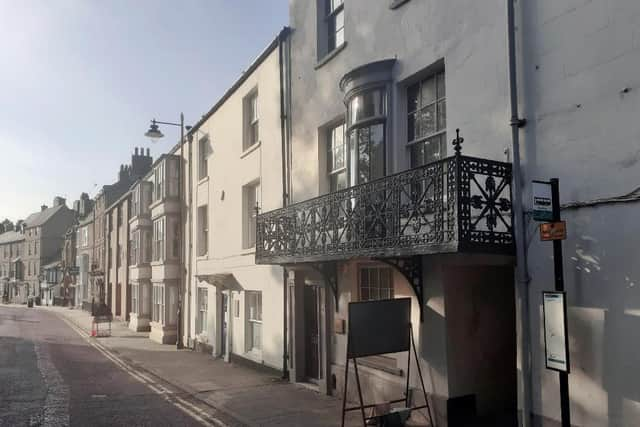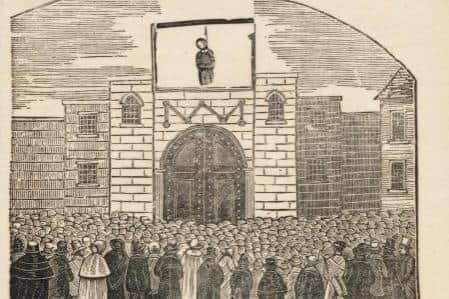The grisly tale of County Durham's last public execution, and the Sunderland barber hanged at the new gallows
and live on Freeview channel 276
If you weren’t working, resting or worshipping there was little else, which partly explains the popularity of public executions.
Hangings were intended as a judicial example to the masses and to deter potential miscreants. In reality they provided a day out for people who wished to whoop it up for a while.
Executions as public entertainment


Advertisement
Hide AdAdvertisement
Hide AdCharles Dickens was among those who watched these “tumultuous demonstrations of indecent delight” in horror.
He wrote to the Times in 1849: “I believe that a sight so inconceivably awful as the wickedness and levity of the immense crowd collected at that execution could be imagined by no man.”
Yet most execution watchers regarded them as we now consider free open-air concerts on bank holidays.
Amateur executioners – oooh


By the 19th century, snowflakes had ended the practice of drawing and quartering, but a good hanging could still draw the crowds. Hordes would travel miles, on foot or by train, to see a public execution.
Advertisement
Hide AdAdvertisement
Hide AdMost of the court cases and subsequent hangings of Wearsiders were dealt with in Durham, so many from Sunderland will have made their way to the gallows in Durham City for the accompanying tomfoolery and banter.
Until 1816 hangings took place where the University of North Durham Hospital now stands. Executioners needed neither experience nor training.
In 1780, Bartholomew Pendleton got the job, his qualification being that his cousin was a canon at Durham Cathedral. His inexperience saw his first punter being inadvertently decapitated instead of hanged, which was awful. It meant that Bartholomew wasn’t paid.


From then on he used a shorter rope. No more heads came off, although the condemned could take up to 30 excruciating minutes to expire. But at least Barty got paid.
Advertisement
Hide AdAdvertisement
Hide AdThe last person to be executed there was one Ann Crampton in 1816, convicted of “cutting and maiming”. We won’t elaborate on what had been cut and maimed, suffice to say that Mr Crampton had little sympathy for his wife’s plight.
A Monkwearmouth man is first on the new gallows
Executions moved to the ‘”new drop” where Durham County Court, built in 1811, still stands. In the court’s brickwork you can still see where the gallows were pegged.


The balcony of a house (now part of Durham University’s sociology department) also still stands opposite on New Elvet; purportedly built for a better view of the new site’s first hanging.
This was on August 17, 1816. A few Mackems probably attended as a local boy was topping the bill. Monkwearmouth barber John Grieg had shot dead Elizabeth Stonehouse for her relentless taunting about his illegitimate child.
Advertisement
Hide AdAdvertisement
Hide AdThe new balcony’s owner apparently sold tickets. Disappointingly for the bumper crowd, the execution went smoothly.
But the fun and frolics ended. The final public hanging in this county, County Durham which included Sunderland then, did not go smoothly.
Indeed, it was so gruesome as to help put paid to the practice altogether. Afterwards you could be terminated in relative privacy, which made your expiry all the more tolerable.


County Durham’s last public execution went horribly badly
The unfortunate subject of this jamboree was Matthew Atkinson, a miner who became an ex-Atkinson on Thursday, March 16, 1865. Eventually.
Advertisement
Hide AdAdvertisement
Hide AdA contemporary written account of his execution enters gleefully into morbidly fascinating and quite unnecessarily gruesome detail about his trial and execution.
He had been convicted of murdering his wife Ellen in a trial that began on March 3. The foreman of the jury was also called Atkinson, but not a relative. The jury took 44 whole minutes to reach their verdict.
Nevertheless, there is little evidence that Atkinson, 43, from Spen in what is now Gateshead, was anything other than a rotter. The court heard that Ellen’s murder on December 17, 1864 took up to an hour. He beat her to death after coming home to find that the fire was out.
In mitigation he told the court that he was drunk and it had been a bit chilly that day. The defence also attempted to reduce the charge to manslaughter, talking up Atkinson’s supposed good character and his wife’s bad one.
Advertisement
Hide AdAdvertisement
Hide AdIt did him no good. He was convicted of “beating his wife in the most unmerciful manner for a full hour” and sentenced to death.
Second time ‘lucky’ for Matthew Atkinson
Before the customary baying mob, an incompetent executioner called Askern put the noose on Atkinson’s neck and pulled the bolt. However, the rope “snapped like a piece of packthread” and the prisoner fell 15 feet onto the court steps.
The crowd cheered and there was great excitement, partly because no one knew exactly what had happened; or if Mr Atkinson was still of this world. Twenty minutes later Mr Askern had another go.
Atkinson, by now in quite exquisite agony, “his neck being circled by a dark mark” after the first botched job and the fall being not jolly either, was now noosed too tightly to be humane, not that humanity guided the agenda at this point, with a rope too thick and too stiff.
Advertisement
Hide AdAdvertisement
Hide AdTherefore: “The consequence was that when the drop fell, the unhappy criminal strugled (sic) frightfully for several seconds before the gallows did its horrible mission.”
Note the gloriously redundant use of the word “unhappy” there. Still, a double hanging meant the balcony spectators got their money’s worth.
Parliamentary reform
Although County Durham only hosted public hangings every couple of years or so, rather like the Ryder Cup, opinion shifted and executions like Matthew Atkinson’s were deemed too grisly and not conducive to light entertainment.
The Capital Punishment Amendment Act 1868 meant the larks were over. No more taking the kiddies the hangings. Executions were thereafter conducted beyond public gaze, such as that of serial killer and tea-spoiler Mary Ann Cotton inside Durham Gaol in 1873.
Pity. The balcony would have been a sell-out for that one.
